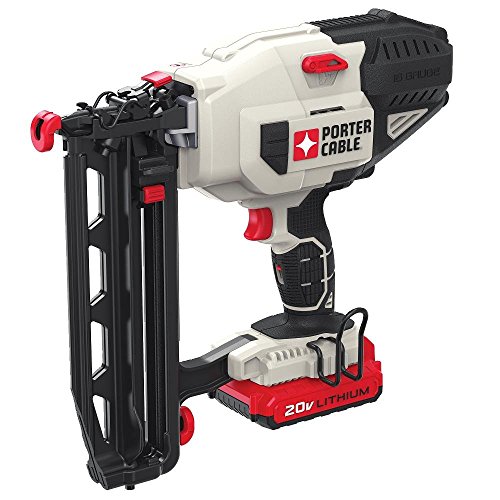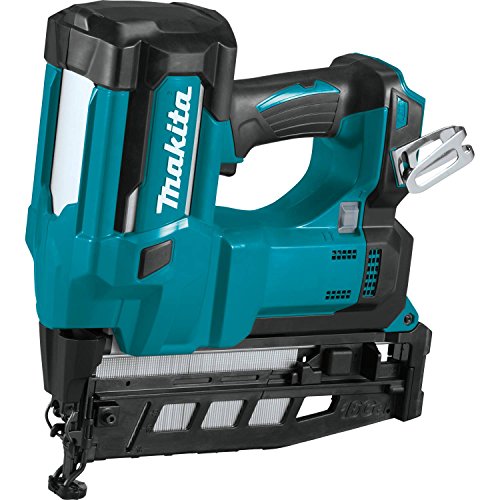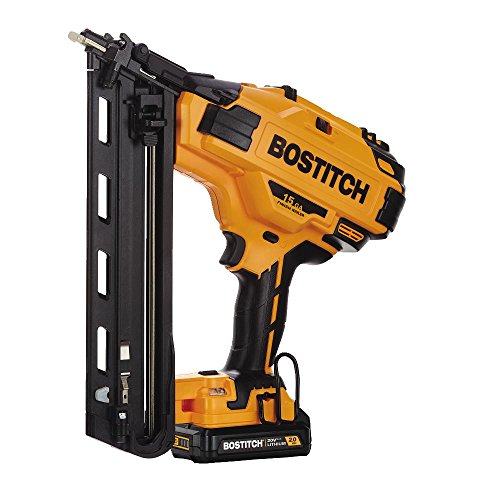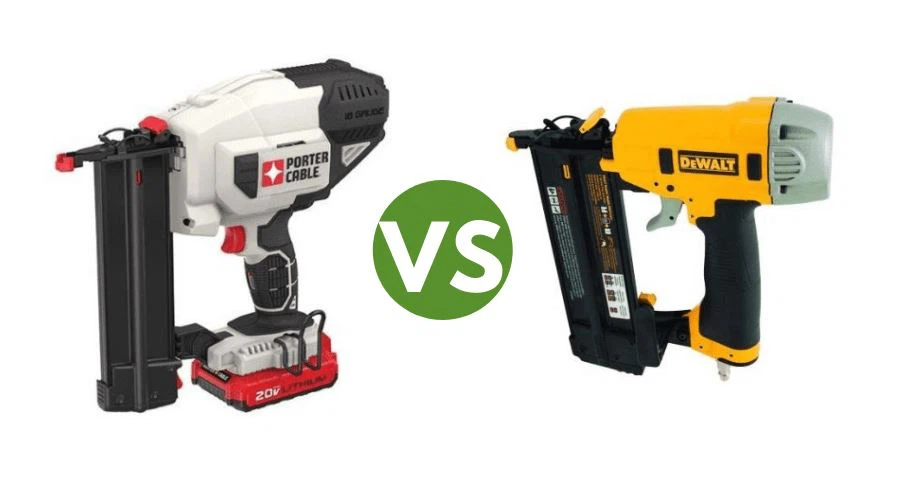As someone who has been reviewing cordless finish nailers for many years, I understand the appeal of these battery-powered tools.
However, with so many products on the market, it can be challenging to decide whether to invest in a pneumatic or cordless nailer.
After all, these tools are critical to the success of woodworkers, carpenters, and construction professionals alike.
To help you make an informed decision and avoid wasting your hard-earned money, I have created a comprehensive guide comparing pneumatic vs cordless nailers.
In this guide, I will cover everything from cost and ergonomics to performance and run time.
By the end of this article, you will have a clear understanding of which type of nailer is best for your needs.
Key Takeaways
- When it comes to cost, pneumatic nailers are generally cheaper than cordless nailers assuming you already have an air compressor.
- Cordless nailers offer greater portability and convenience, but pneumatic nailers tend to be more ergonomic and offer better performance.
- The decision between a cordless and pneumatic nailer ultimately comes down to personal preference and the type of work you will be doing.
Pneumatic vs Cordless Nailers: Cost
When comparing the cost of pneumatic and cordless nailers, it’s important to consider both the initial purchase price and any additional accessories required for operation.
Cordless nailers, such as the Milwaukee M18 FUEL 18ga brad nailer, typically come with a higher initial price tag, with a bare tool price of around $279.
In contrast, pneumatic nailers from brands like Makita, Senco, and DeWalt usually range between $70 and $99 for a similar pneumatic model.
However, the total cost of ownership for a cordless nailer extends beyond the initial purchase.
When factoring in the cost of a 3Ah battery and charger, the price can increase to $399.
Pneumatic nailers require a good compressor, like the Rolair VT25BIG, along with a hose and fittings, which can bring the cost of entry to a comparable level with cordless nailers.
For professionals who require multiple nailers, the overall cost consideration becomes more complex. Adding additional nailers, such as a narrow crown stapler or a larger finish nailer, significantly impacts the total investment.
The Milwaukee M18 FUEL nailers, for example, range from $299 without a battery and charger to $399 to $429 when purchased as a kit.
Ultimately, while cordless nailers may have a higher upfront cost, the long-term cost of ownership should be carefully evaluated, especially when considering the need for multiple nailers and associated batteries.

- This cordless finish nailer is 100% battery power eliminates need for a compressor, hose or costly gas cartridges
- Motor design of the 16 gauge finish nailer provides consistent firing power into various materials and climate conditions
Pneumatic vs Cordless Nailers: Ergonomics
When it comes to ergonomics, weight is a crucial factor to consider.
Pneumatic models are much lighter than cordless ones, even after taking into account the weight of the hose.
For instance, a finish nailer weighs around 2 pounds, while a battery-powered model can weigh 7 pounds or more.
Cordless nailers have an advantage in terms of portability.
You don’t have to drag around a hose, which can throw off the balance of the nailer while working at various heights and angles.
Additionally, you’re not tethered to a specified length, which can limit your mobility.
Another benefit of cordless nailers is that they don’t produce compressor noise, which can be a major plus if you’re working in an area where people are present.
In terms of ease of use and maneuverability, cordless nailers are generally more convenient. They are lightweight tools that are easy to move around with, and they don’t have any cords, wires, or hoses to inhibit movement.

- Cordless for increased convenience, eliminates the need for a compressor and air hose
- Compact center height enables viewing around the nose tip when fastening in tight spots
Pneumatic vs Cordless Nailer Performance
When it comes to performance, both pneumatic and cordless nailers can get the job done.
However, there are some differences in the firing cycle that are worth noting.
Pneumatic nailers fire immediately upon pulling the trigger, while cordless models may have a slight delay due to the technology used in the battery-powered nailer.
Flywheel-based Cordless Nailers
Cordless nailers that use a flywheel require the flywheel to spin up before firing a nail. This can result in a delay of about a second before the first nail is fired.
This type of cordless nailer can be frustrating to use and differs significantly from the feel of a pneumatic tool.
Some brands that use flywheel technology include Porter-Cable, Bostitch, and DeWalt cordless nailers.
Nitrogen Cylinder-based Cordless Nailers
Gas cylinder nailers use a captive volume of nitrogen that is pressurized by the battery and motor.
This type of cordless nailer is ready to fire instantly, much like a pneumatic nailer. The system works as a closed-loop system, and the driver shoots a nail the instant the trigger is pulled.
Nitrogen cylinder-based cordless nailers tend to be smaller in size since they use a more compact firing mechanism.
Brands that use this type of technology include Milwaukee, Senco, and Metabo HPT cordless nailers.
In terms of power source, pneumatic nailers require an air compressor to operate, while cordless nailers use batteries.
Cordless nail guns are more portable than pneumatic nailers and are ideal for jobs where a power source is not readily available.
When it comes to force, both pneumatic and cordless nailers can provide enough power to fasten nails into softwood and other materials.
The firing rate of cordless nailers may be slower than that of pneumatic nailers, but this can depend on the specific model and brand.
Different types of nailers are available for different types of fastening, including framing nailers, finish nailers, brad nailers, and narrow crown staplers.
Each type of nailer is designed for specific applications and uses different fasteners.
Nail depth can also vary between different nailers, with some models allowing for adjustable nail depth.
Proper maintenance is important for both pneumatic and cordless nailers to ensure they fire effectively and stay jam-free.

- Drives 15 GA FN Style Angled Finish Nails from 1-1/4-inch to 2-1/2-inch length with this cordless finish nailer
- Narrow nose of 15 gauge finish nailer is designed for clear line of sight and accuracy of nail placement
Cordless vs Pneumatic Nailers: Run Time
When it comes to run time, pneumatic nailers have an advantage over cordless nailers.
Pneumatic nailers can run continuously as long as the power source is available.
On the other hand, cordless nailers rely on battery life, which can be limiting.
Cordless nailers have come a long way in terms of battery technology.
With rechargeable lithium-ion batteries and brushless motors, some cordless nailers can fire more than 1600 shots on a single charge.
Even with a compact battery, it’s unlikely that you’ll outwork two batteries being cycled.
For longer and larger jobs, pneumatic nailers still make a lot of sense.
It’s rare to have an issue with the power, compressor, or hose. For most work, run time isn’t the limiting factor. Instead, we turn back once again to weight and overall ergonomics.
Maintenance of Pneumatic vs Cordless Nailers
As a professional, I understand the importance of proper maintenance for tools to ensure they perform at their best.
When it comes to nailers, there are differences in maintenance between pneumatic and cordless models.
Pneumatic nailers have a simpler design, but they require more components to be connected.
It is crucial to ensure that the hose is not leaking and that all couplers and NPT connections are well-sealed.
Additionally, the compressor must have enough gas or be plugged into a reliable power source.
Daily oiling of the nailer and keeping track of the compressor’s oil levels are also necessary.
Cordless nailers require fewer connections, but they have more moving parts, including electronics and a motor.
While they are simpler to set up, they introduce additional complexity to an otherwise straightforward tool.
When considering maintenance, the manufacturer’s warranty comes into play.
Most people lack the necessary training and skills to repair a battery-powered nailer, so having warranty recourse is essential.
This warranty will give you an idea of how long you can reasonably expect to use the tool.
It is important to note that pneumatic nailers can be quite noisy due to the compressor, which could require additional soundproofing measures in a workspace.

Pneumatic vs Cordless Nailers: Setup and Take Down
Setting up a pneumatic nailer requires bringing the compressor and nailer to the worksite, connecting the hose and couplers, and getting the compressor up to operating pressure.
This process can take over 6 minutes, not including the time spent hiking through or around a house to the back yard or going upstairs.
At the end of the day, the same process must be repeated to get the gear back to the truck.
In contrast, setting up a cordless nailer is much simpler and quicker.
It only takes about 30 seconds to get the cordless nailer ready for use.
With a couple of room changes, using a cordless nailer system can easily save you 30 minutes.
Using a cordless nailer system eliminates the need to move the compressor and hose around the jobsite, which can be a time-consuming and tiring process.
This is especially true if you need to move the compressor and hose up and down stairs or through tight spaces.
In terms of hoses, pneumatic nailers require a hose to connect the nailer to the compressor, which can be cumbersome and limit your range of movement.
In contrast, cordless nailers do not require a hose, which gives you greater freedom of movement and allows you to work in tight spaces and hard-to-reach areas.
Overall, when it comes to setup and take down, a cordless nailer system is much quicker and easier to use than a pneumatic nailer system. It saves time and eliminates the need to move heavy equipment around the jobsite.
The Bottom Line
When it comes to the debate between pneumatic and cordless nailers, there is no one-size-fits-all answer.
Both types of nailers have their advantages and are best suited for different tasks.
For larger projects such as framing, built-ins, or trimming out an entire house, pneumatic nailers are recommended for their cost-effectiveness and ergonomic benefits.
The lower cost and lighter weight of pneumatic nailers make them ideal for extended use on substantial projects.
For punch list and smaller project work, a battery-powered cordless nailer can significantly speed up the setup and tear-down process.
The portability and quick operation of cordless nailers make them well-suited for smaller tasks.
Both pneumatic and cordless nailers have their place in the toolbox.
The decision ultimately depends on the specific needs of the project and the user’s preferences.
As such, neither type of nailer is likely to completely replace the other in the near future.
Frequently Asked Questions
What are the advantages of using a pneumatic nailer over a cordless model?
Pneumatic nailers are generally more powerful and efficient than cordless models. They are also less expensive and more durable, making them a better choice for heavy-duty projects.
How do cordless nailers perform compared to pneumatic nailers in terms of power and efficiency?
Cordless nailers are not as powerful as pneumatic models but they are still capable of driving nails into most types of wood. They are also more efficient than pneumatic nailers because they don’t require an air compressor or hose, which can be cumbersome to move around a job site.
What are the maintenance differences between pneumatic and cordless nailers?
Pneumatic nailers require regular oiling and cleaning to keep them running smoothly. Cordless nailers require less maintenance but their batteries need to be charged regularly.
Can cordless nailers match the durability and longevity of pneumatic nailers?
Cordless nailers are generally not as durable or long-lasting as pneumatic nailers. However, they are improving in quality and can still last for many years with proper care.
What considerations should be made when choosing between a pneumatic and a cordless framing nailer?
When choosing between a pneumatic and a cordless framing nailer, consider the type of projects you will be working on, the amount of power you need, and the amount of mobility you require. Pneumatic nailers are better for heavy-duty projects while cordless nailers are better for smaller, more mobile projects.
How do the costs of owning and operating pneumatic nailers compare to cordless nailers over time?
Pneumatic nailers are generally less expensive to purchase than cordless nailers, but they require an air compressor and hose, which can add to the overall cost. Cordless nailers are more expensive upfront but require less maintenance and don’t require an air compressor or hose, which can save money over time.
Join 7,000+ subscribers to get access to drawings, build plans, and tool hacks every week.
Reader Interactions